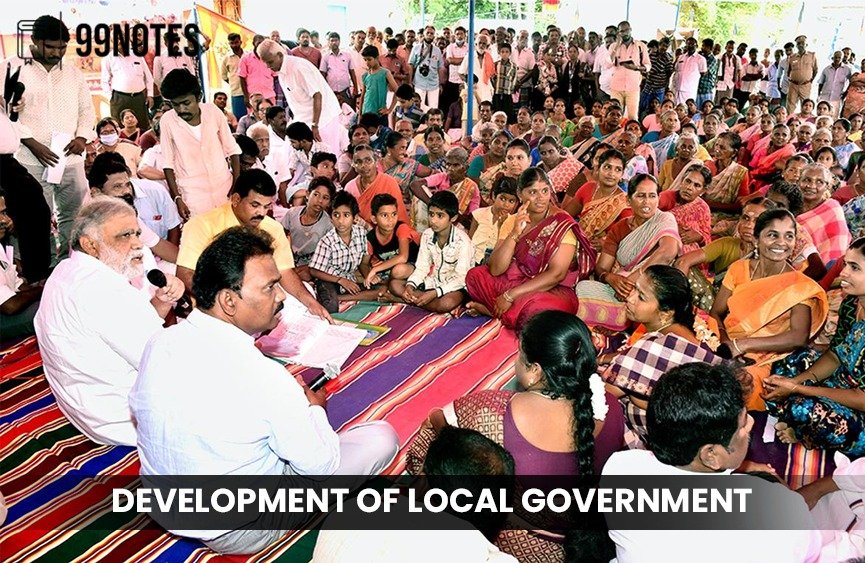DEVELOPMENT OF LOCAL GOVERNMENT
- Historical Evolution of Local Government
- 73rd and 74th Constitutional Amendments (1992)
- Impact of Panchayati Raj System
- Role and Functioning of Local Governments
- 1. Rural Local Bodies
- Functions of PRIs
- Structure and Composition of PRIs
- Sources of Funding for PRIs
- Functions of ULBs
- Structure and Composition of ULBs
- Sources of Revenue for ULBs
- Challenges in Local Governance
- 1. Lack of Financial Autonomy
- 3. Capacity Constraints
- 4. Corruption and Mismanagement
- 5. Urban-Rural Disparity
- Strengthening Local Governance
- 1. Empowering Local Bodies with Financial Independence
- 2.Capacity Building and Digital Governance
- 3.Strengthening Gram Sabhas for Participatory Democracy
- 3.Greater Urban Planning for Sustainable Cities
- Examples and Best Practices
- Related FAQs of DEVELOPMENT OF LOCAL GOVERNMENT
 The 73rd and 74th Constitutional Amendments of 1992 were pivotal in reinforcing the framework for local self-government in India. These amendments granted constitutional status to Panchayati Raj Institutions (PRIs) in rural areas and Urban Local Bodies (ULBs) in urban areas, instituting key provisions like regular elections, reservations for marginalized communities and women, and devolution of financial and administrative powers. This decentralization has enhanced local governance, enabling more effective and participatory decision-making, and ensuring that the development needs of local communities are addressed efficiently.
The 73rd and 74th Constitutional Amendments of 1992 were pivotal in reinforcing the framework for local self-government in India. These amendments granted constitutional status to Panchayati Raj Institutions (PRIs) in rural areas and Urban Local Bodies (ULBs) in urban areas, instituting key provisions like regular elections, reservations for marginalized communities and women, and devolution of financial and administrative powers. This decentralization has enhanced local governance, enabling more effective and participatory decision-making, and ensuring that the development needs of local communities are addressed efficiently.
Historical Evolution of Local Government
1. Ancient Period
Local governance in India has deep historical roots, dating back to the ancient period. The concept of village self-rule was well established through institutions like Gram Sabhas and village councils. Villages were largely self-sufficient units where local issues were resolved through collective decision-making. The Gram Sabha (village assembly) was a powerful institution where elders and elected representatives took decisions on matters such as land disputes, resource management, and social issues. The system ensured participatory governance and a high degree of local autonomy.
2. Medieval Period
The system of local governance weakened during the medieval period due to the rise of centralized rule under the Delhi Sultanate and the Mughal Empire. Administrative authority was concentrated at the imperial level, and local governance structures were reduced to instruments of tax collection and law enforcement. While village councils continued to exist informally, their powers were limited, and decision-making shifted to the central and provincial levels under the control of the nobility and zamindars (landlords).
3. British Period
The British colonial administration introduced structured municipal governance but retained centralized control, limiting the autonomy of local bodies. Key developments during the British period included:
- Introduction of municipal governance – The first municipal corporation was established in Madras (1687), followed by Bombay and Calcutta (1726). These were primarily aimed at improving sanitation, infrastructure, and trade regulation in colonial settlements.
- Lord Ripon’s Resolution (1882) – Lord Ripon is regarded as the “Father of Local Self-Government in India.” His resolution emphasized the importance of elected local bodies and advocated for the establishment of municipalities with greater local autonomy and citizen participation.
- Government of India Acts (1919 and 1935) – The Government of India Act, 1919 introduced the concept of dyarchy, which transferred certain local governance functions to Indian ministers. The Government of India Act, 1935 expanded provincial autonomy and strengthened local bodies by allowing provincial governments to manage local governance structures more independently.
The colonial era laid the groundwork for formal local governance structures, but the British maintained ultimate authority, limiting the democratic potential of local self-governance. The real transformation in local governance came after independence, particularly with the constitutional recognition of local government through the 73rd and 74th Amendments.
4. Post-Independence Development
After independence, local governance gained renewed attention as a key instrument for strengthening democracy and promoting rural development. The focus shifted toward empowering local bodies to address the socio-economic challenges at the grassroots level.
Constitutional Provisions (1950): The Constitution of India (1950) recognized the importance of local self-governance under the Directive Principles of State Policy (DPSP).
- Article 40 of the Constitution directs the state to “organize village panchayats and endow them with such powers and authority as may be necessary to enable them to function as units of self-government.”
- While the Constitution recognized the importance of local governance, it did not initially provide a clear institutional framework or mandatory provisions for the establishment of local bodies.
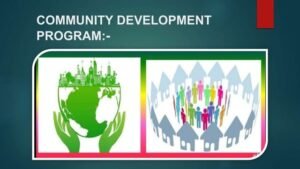 Community Development Programme (1952): The Community Development Programme (CDP) was launched in 1952 as the first major initiative for rural development and local participation.
Community Development Programme (1952): The Community Development Programme (CDP) was launched in 1952 as the first major initiative for rural development and local participation.
- It aimed to provide a framework for integrated rural development through community participation.
The CDP focused on improving agriculture, irrigation, health, education, and rural infrastructure through village-level planning and execution.
However, the programme faced challenges due to lack of local capacity and weak coordination among various government agencies.
Balwant Rai Mehta Committee (1957): The Balwant Rai Mehta Committee was appointed in 1957 to review the working of the Community Development Programme and the National Extension Service.
The committee recommended the establishment of a three-tier Panchayati Raj system at the village, block, and district levels:
- Gram Panchayat (village level)
- Panchayat Samiti (block level)
- Zila Parishad (district level)
- It emphasized the need for direct elections to local bodies and greater involvement of the people in local governance.
- The first Panchayati Raj system was implemented in Nagaur, Rajasthan (1959), followed by Andhra Pradesh and other states.
- The system, however, suffered from financial dependence on the state government and lack of adequate devolution of power.
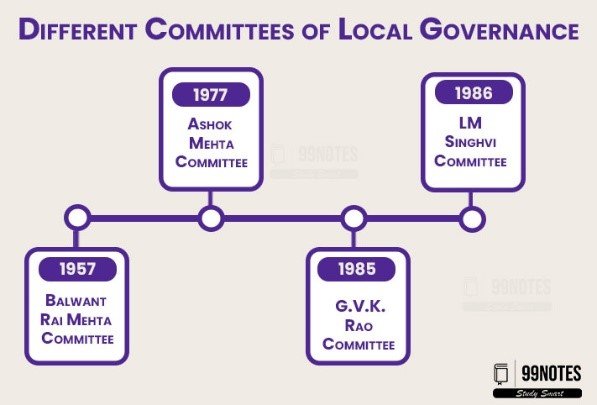 Ashok Mehta Committee (1977): The Ashok Mehta Committee was appointed in 1977 to review the Panchayati Raj system and suggest reforms.
Ashok Mehta Committee (1977): The Ashok Mehta Committee was appointed in 1977 to review the Panchayati Raj system and suggest reforms.- The committee recommended a shift from the three-tier system to a two-tier system consisting of:
- Zila Parishad (district level)
- Mandal Panchayat (group of villages)
- It stressed the need for greater functional autonomy and financial independence of local bodies.
- The committee also recommended direct elections to local bodies and greater involvement of political parties in local governance.
- espite the recommendations, the implementation of the two-tier system was limited due to political and administrative resistance.
The post-independence period laid the foundation for the establishment of a structured local government system. However, the real breakthrough came with the constitutional amendments in the early 1990s, which gave constitutional status to local bodies and ensured direct democratic participation at the grassroots level.
73rd and 74th Constitutional Amendments (1992)
The 73rd and 74th Constitutional Amendments passed in 1992 marked a significant turning point in the history of local governance in India. They provided constitutional status to rural and urban local bodies, institutionalized democratic decentralization, and empowered local governments to function as self-governing units.
73rd Amendment (1992)
The 73rd Constitutional Amendment Act came into force on 24 April 1993 and laid down the framework for a uniform system of Panchayati Raj Institutions (PRIs) across the country.
- Three-tier system – The amendment introduced a three-tier system of local governance:
- Gram Panchayat – Village level
- Panchayat Samiti – Block level
- Zilla Parishad – District level
- Direct Elections – Members of all levels of the Panchayati Raj system are elected directly by the people.
Reservation of Seats –
- Scheduled Castes (SCs) and Scheduled Tribes (STs) – Reservation of seats in proportion to their population.
- Women – Minimum 33% reservation of seats at all levels for women, including positions of chairpersons (increased to 50% in some states later).
- State Election Commission – Independent body responsible for conducting free and fair elections to PRIs, which is headed by a State Election Commissioner appointed by the Governor.
- State Finance Commission – Constitution of a State Finance Commission every five years to review the financial position of PRIs and recommend devolution of funds. Ensured regular and predictable financial flow to Panchayati Raj Institutions.
- Powers and Responsibilities –
- Preparation of plans for economic development and social justice.
- Implementation of schemes related to agriculture, land improvement, irrigation, rural housing, health, education, and social welfare.
- States were empowered to determine the specific powers and functions of PRIs.
Impact of Panchayati Raj System
The Panchayati Raj System, introduced through the 73rd Constitutional Amendment Act (1992), aimed to promote decentralized governance and empower local self-governments. It strengthened grassroots democracy by involving citizens directly in decision-making and ensuring better representation of marginalized communities.
- Strengthened Grassroots Democracy: Enabled direct participation of citizens in governance and decision-making at the village level.
- Empowerment of Marginalized Sections: Ensured political representation and empowerment of SCs, STs, and women through constitutional reservations.
- Enhanced Local Governance: Improved planning and implementation of development schemes through local bodies, ensuring better accountability.
- Financial Independence: Panchayats received financial powers and grants, enhancing their ability to implement local development projects.
- Administrative Decentralization: Transferred powers and responsibilities to local governments, improving service delivery and local administration.
 74th Amendment (1992)
74th Amendment (1992)
The 74th Constitutional Amendment Act came into effect on 1 June 1993 and provided a constitutional framework for urban local governance. It aimed to strengthen the structure and functioning of urban local bodies (ULBs) to address the challenges of rapid urbanization.
- Three-tier system of urban local governance –
- Municipal Corporations – For large urban areas
- Municipalities – For smaller urban areas
- Nagar Panchayats – For transitional areas (rural to urban)
- Direct Elections – Members of all urban local bodies are directly elected by the people.
- Functional Autonomy and Financial Empowerment –
- Powers and responsibilities related to urban planning, infrastructure, public health, sanitation, water supply, solid waste management, etc.
- Authority to levy taxes, collect user charges, and receive grants from state and central governments.
- Ward Committees – Constitution of ward committees in larger urban areas to promote participatory governance at the local level.
- Mayoral System – Mayor as the executive head of the municipal body with administrative and political powers.
- Role of mayor varies across states (ceremonial or executive).
- State Election Commission – Independent body responsible for conducting municipal elections and ensures free and fair electoral processes.
Impact of 74th Amendments
The reforms in urban governance aimed to decentralize power and improve the efficiency and inclusiveness of urban administration. These changes brought lasting structural and functional improvements to city management.
- Strengthened urban governance by creating institutional frameworks with defined roles and responsibilities.
- Improved transparency and accountability in local bodies through structured administrative processes.
- Encouraged active citizen participation in planning, budgeting, and decision-making at the municipal level.
- Enhanced the delivery and management of urban infrastructure, including water, sanitation, and waste systems.
- Supported sustainable urban development through better coordination between agencies and long-term planning.
The 73rd and 74th Amendments established a uniform framework for local governance in both rural and urban areas, strengthening participatory democracy and decentralized planning. However, challenges related to financial independence, administrative capacity, and political interference continue to limit the full realization of the potential of local self-governance in India.
Role and Functioning of Local Governments
Local governments in India, established through the 73rd and 74th Constitutional Amendments of 1992, serve as the third tier of governance, empowering rural and urban areas with constitutional status. They play a crucial role in promoting grassroots democracy, ensuring public participation, and delivering essential services to local communities. These bodies are instrumental in facilitating democratic decentralization, enhancing governance effectiveness, and driving inclusive development.
The system of local governments in India is divided into two broad categories:
- Rural Local Bodies – Panchayati Raj Institutions (PRIs)
- Urban Local Bodies (ULBs) – Municipal corporations, municipalities, and Nagar Panchayats
1. Ru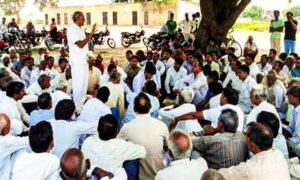 ral Local Bodies
ral Local Bodies
Panchayati Raj Institutions (PRIs) are responsible for governance and development in rural areas. They have a three-tier structure as per the 73rd Constitutional Amendment:
- Gram Panchayat – Village level
- Panchayat Samiti – Block level
- Zilla Parishad – District level
PRIs derive their powers and functions from the Eleventh Schedule of the Constitution, which outlines 29 subjects under their jurisdiction. These include agriculture, rural infrastructure, health, education, sanitation, water supply, social welfare, and poverty alleviation.
Functions of PRIs
Panchayati Raj Institutions (PRIs) play a crucial role in rural governance by focusing on the overall development and welfare of rural communities. They perform both developmental and regulatory functions, ensuring that rural areas receive essential services and support for growth.
- Agriculture and irrigation: PRIs promote agricultural productivity by overseeing irrigation projects, soil conservation initiatives, and efficient water management to boost farm yields.
- Health and sanitation: They manage rural health centers, vaccination programs, and sanitation services to ensure better health outcomes for rural populations.
- Education: PRIs oversee primary and secondary schools, facilitate adult literacy programs, and run mid-day meal schemes to enhance education in rural areas.
- Social welfare: They implement welfare programs targeted at women, children, scheduled castes (SCs), scheduled tribes (STs), and other vulnerable communities to ensure social equity.
- Infrastructure development: PRIs are responsible for constructing and maintaining rural roads, street lighting, drainage systems, and public buildings to improve the living standards of rural inhabitants.
- Livelihood and poverty alleviation: They implement schemes like MGNREGA (Mahatma Gandhi National Rural Employment Guarantee Act) to provide rural employment opportunities and reduce poverty.
- Natural resource management: PRIs manage rural natural resources, including forests, water bodies, and common grazing lands, ensuring sustainable development and conservation.
Structure and Composition of PRIs
- Gram Panchayat – Directly elected by the village population. The Sarpanch (head) is the elected representative of the village.
- Panchayat Samiti – Comprises representatives from villages under its jurisdiction and is headed by the Pradhan (President).
- Zilla Parishad – Highest tier at the district level, comprising elected representatives from Panchayat Samitis and chaired by the Zilla Parishad Chairman.
Sources of Funding for PRIs
PRIs depend on multiple sources of funding for their functioning:
- State grants – Based on recommendations of the State Finance Commission.
- Central schemes – Funds under centrally sponsored schemes such as MGNREGA, PMGSY (Pradhan Mantri Gram Sadak Yojana), and NRLM (National Rural Livelihood Mission).
- Own revenue – Local taxes (house tax, water tax), fees (trade licenses), and user charges.
- Loans and borrowings – From financial institutions like NABARD (National Bank for Agriculture and Rural Development).
2. Urban Local Bodies (ULBs)
Urban Local Bodies (ULBs) govern cities and towns, managing urban infrastructure, public services, and local economic development. The 74th Constitutional Amendment Act institutionalized ULBs and gave them constitutional status. ULBs are classified into three categories:
- Municipal Corporation – For larger urban areas (e.g., Delhi, Mumbai, Kolkata).
- Municipality – For medium-sized towns.
- Nagar Panchayat – For smaller towns and transitioning rural areas.
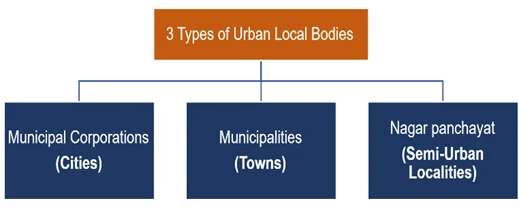
ULBs derive their powers and functions from the Twelfth Schedule of the Constitution, which lists 18 subjects, including urban planning, slum improvement, public health, water supply, sanitation, waste management, and transport.
Functions of ULBs
Urban Local Bodies (ULBs) play a vital role in managing and developing urban areas by ensuring the efficient delivery of public services and promoting overall urban welfare. Their functions cover a wide range of services essential for the well-being of urban populations.
- Urban planning: ULBs are responsible for formulating zoning regulations, town planning, and land-use policies to ensure organized urban development.
- Water supply and sewerage: ULBs manage the provision of clean drinking water and the effective management of wastewater systems to maintain public health.
- Public health: They run hospitals, dispensaries, vaccination programs, and sanitation services to promote community health and hygiene.
- Waste management: ULBs handle the collection, processing, and disposal of solid waste to keep urban areas clean and prevent environmental hazards.
- Urban transport: They oversee public transport systems, manage road infrastructure, and regulate traffic to ensure smooth movement in cities.
- Education: ULBs maintain and manage schools, promoting literacy and educational programs for urban residents.
- Housing and slum development: ULBs work on developing affordable housing and improving slum infrastructure to address urban poverty and improve living conditions.
Structure and Composition of ULBs
- Municipal Corporation – Headed by a Mayor and consists of elected representatives (corporators).
- Municipality – Headed by a Chairman and includes elected representatives.
- Nagar Panchayat – Headed by a President and functions similarly to a Municipality but on a smaller scale.
Sources of Revenue for ULBs
Urban Local Bodies (ULBs) generate revenue through various sources to fund their operations and development projects. These sources ensure that ULBs have the financial capacity to deliver essential services and infrastructure in urban areas.
- Property tax: The primary source of income for ULBs, levied on residential and commercial properties.
- User charges: Revenue from services like water supply, waste collection, and parking fees, charged to residents and businesses.
- State and central grants: Funds allocated through schemes like the Smart Cities Mission and AMRUT (Atal Mission for Rejuvenation and Urban Transformation).
- Borrowings and bonds: Municipal bonds and loans from financial institutions used to finance large-scale urban projects.
- Professional tax and entertainment tax: Local taxes imposed on professionals and entertainment activities within the jurisdiction of ULBs.
Local governments remain the foundation of India’s democratic system. Strengthening their financial, administrative, and functional autonomy is essential to improving service delivery, promoting inclusive development, and enhancing citizen participation in governance.
Challenges in Local Governance
Local governments in India play a crucial role in grassroots governance and delivering essential services. However, despite constitutional provisions and increased devolution of powers, local governments face several structural, financial, and administrative challenges that hinder their effective functioning. These challenges undermine the goal of decentralized governance and limit the potential of local bodies to respond to local needs effectively.
1. Lack of Financial Autonomy
Local governments in India remain heavily dependent on financial transfers from state and central governments. This lack of financial autonomy restricts their ability to undertake independent developmental initiatives and meet the specific needs of the population.
- Dependence on grants – A significant portion of the revenue for Panchayati Raj Institutions (PRIs) and Urban Local Bodies (ULBs) comes from state and central grants rather than locally generated revenue.
- Poor tax collection – Local governments are empowered to levy taxes such as property tax, professional tax, and water charges, but poor administrative capacity and low tax compliance rates reduce the effectiveness of these revenue sources.
- Delayed fund release – State governments often delay the release of funds to local bodies, disrupting planning and execution of developmental projects.
- Mismatch between responsibilities and resources – While the 73rd and 74th Amendments assigned a wide range of functions to local bodies, the financial resources allocated to them are often insufficient to carry out these functions effectively.
- Limited borrowing powers – Local bodies have restricted access to borrowing from financial institutions and capital markets, which limits their ability to invest in long-term infrastructure projects.
2. Political Interference
Local governance is often undermined by excessive political and bureaucratic control, which prevents local bodies from functioning independently and effectively.
- State control over local bodies – State governments exercise considerable control over the functioning of local bodies through administrative oversight and fund allocation.
- Bureaucratic dominance – Bureaucrats appointed by state governments often have greater decision-making power than elected representatives at the local level.
- Frequent political changes – Instability at the state level often results in policy changes that affect the functioning of local bodies.
- Centralization of power – Despite the constitutional mandate for decentralization, actual decision-making power remains concentrated at the state and central levels.
3. Capacity Constraints
Local governments face significant capacity constraints due to a lack of trained personnel, poor infrastructure, and inadequate technical know-how.
- Shortage of skilled personnel – Many local bodies lack qualified staff to manage administrative functions, implement projects, and deliver services effectively.
- Inadequate training – Elected representatives and administrative staff often lack the training needed to understand governance processes, financial management, and project execution.
- Limited technical expertise – Local governments struggle with urban planning, waste management, and public health due to the absence of technical experts.
- High vacancy rates – A large number of sanctioned posts in local governments remain vacant, leading to poor service delivery and administrative delays.
- Poor infrastructure – Lack of office space, equipment, and communication facilities hampers the efficient functioning of local bodies.
4. Corruption and Mismanagement
Corruption and mismanagement in local governance weaken public trust, lead to financial leakages, and reduce the quality of public services.
- Misuse of funds – Funds allocated for local development projects are often diverted or misused due to poor oversight and lack of transparency.
- Nepotism and favoritism – Political patronage and vested interests influence the allocation of funds and contracts at the local level.
- Poor auditing and accountability – Weak auditing mechanisms and lack of public oversight allow corruption to flourish at the local level.
- Ghost beneficiaries – Welfare schemes implemented by local bodies often suffer from irregularities such as the presence of non-existent beneficiaries.
- Delay in project completion – Corruption and administrative inefficiencies result in time and cost overruns in infrastructure projects.
5. Urban-Rural Disparity
Significant disparities exist between rural and urban local governance, leading to uneven development and service delivery.
- Infrastructure gap – Rural areas suffer from poor infrastructure, including roads, electricity, water supply, and internet connectivity, compared to urban areas.
- Healthcare and education disparities – Rural health centers and schools are often understaffed and poorly equipped, while urban areas benefit from better facilities.
- Digital divide – Urban areas have better access to digital infrastructure and e-governance services, while rural areas remain underserved.
- Funding imbalance – Central and state government schemes often allocate more funds to urban infrastructure projects, leaving rural development underfunded.
- Migration pressures – Inadequate livelihood opportunities and poor infrastructure in rural areas drive migration to urban centers, creating additional strain on urban local bodies.
Strengthening Local Governance
Strengthening local governance is essential for enhancing grassroots democracy, improving service delivery, and ensuring inclusive and sustainable development. Despite the constitutional mandate provided by the 73rd and 74th Amendments, local governments in India face structural, financial, and administrative challenges that limit their effectiveness. Strengthening local governance requires empowering local bodies with financial independence, building administrative capacity, encouraging participatory democracy, and improving urban and rural infrastructure through better planning and technological integration.
1. Empowering Local Bodies with Financial Independence
 Financial autonomy is crucial for effective governance and the successful implementation of local development projects. Providing local bodies with greater control over revenue generation and expenditure can enhance their capacity to address local needs independently.
Financial autonomy is crucial for effective governance and the successful implementation of local development projects. Providing local bodies with greater control over revenue generation and expenditure can enhance their capacity to address local needs independently.
- Enhancing local revenue generation – Local bodies should be empowered to increase property tax collection, impose user charges, and generate revenue from local resources.
- Devolving financial powers – State governments should devolve more financial powers to Panchayati Raj Institutions (PRIs) and Urban Local Bodies (ULBs) for better financial planning and execution.
- Increased allocation under central and state schemes – Programs like the Mahatma Gandhi National Rural Employment Guarantee Act (MGNREGA), Smart Cities Mission, and AMRUT should allocate greater resources to local bodies.
- Municipal bonds and innovative financing – ULBs should be encouraged to raise funds through municipal bonds, public-private partnerships (PPP), and infrastructure development funds.
- Direct fund transfer mechanism – Ensuring direct transfer of central and state funds to local bodies without intermediary interference will improve financial autonomy and accountability.
- State Finance Commission recommendations – Implementing the recommendations of State Finance Commissions (SFCs) will strengthen financial devolution and ensure better fund utilization.
2.Capacity Building and Digital Governance
Capacity building and the adoption of digital governance tools are essential for improving the administrative efficiency and transparency of local bodies.
- Training of elected representatives and staff – Regular training on governance, financial management, urban and rural planning, and digital tools will enhance administrative capacity.
- Recruitment of technical experts – Appointing experts in urban planning, waste management, public health, and financial management will improve decision-making and service delivery.
- e-Governance platforms – Implementing integrated e-governance platforms for citizen grievance redressal, service delivery, and real-time monitoring of developmental projects will increase transparency and efficiency.
- Digital payment systems – Promoting online payment of property taxes, utility bills, and other local fees will improve revenue collection and reduce leakages.
- GIS and data-driven governance – Using Geographic Information Systems (GIS) and data analytics for urban planning, infrastructure development, and disaster management will enhance decision-making.
- Urban Local Body (ULB) portals – Establishing dedicated portals for ULBs to track budget allocation, expenditure, and citizen feedback will improve governance accountability.
3.Strengthening Gram Sabhas for Participatory Democracy
Gram Sabhas play a critical role in ensuring direct citizen participation in local governance, enhancing accountability, and empowering marginalized communities. Strengthening the functioning and decision-making power of Gram Sabhas can deepen grassroots democracy.
- Mandatory regular meetings – Holding Gram Sabha meetings at regular intervals with mandatory quorum requirements will ensure broader participation.
- Participatory budgeting – Allowing citizens to decide the allocation of funds for local development projects will improve resource utilization and reduce corruption.
- Social audits – Conducting social audits of developmental projects and welfare schemes will ensure transparency and prevent fund misuse.
- Empowering Gram Sabhas in planning – Granting Gram Sabhas the authority to approve village development plans and monitor implementation will strengthen local accountability.
- Inclusion of marginalized groups – Ensuring the participation of women, Scheduled Castes (SCs), Scheduled Tribes (STs), and other marginalized communities in decision-making will promote social justice.
- Model Gram Sabhas – Promoting successful Gram Sabha models from states like Kerala and Madhya Pradesh will encourage other villages to adopt similar practices.
3.Greater Urban Planning for Sustainable Cities
Urban governance requires strategic planning to address challenges related to rapid urbanization, environmental sustainability, and infrastructure development. Strengthening urban local governance through better planning, technological interventions, and increased citizen participation is essential for sustainable urban development.
- Smart Cities Mission – The Smart Cities Mission promotes the use of technology, data-driven governance, and infrastructure improvement in selected cities. The focus should be on expanding the initiative to more cities and ensuring citizen involvement in the planning process.
- AMRUT (Atal Mission for Rejuvenation and Urban Transformation) – AMRUT aims to improve urban infrastructure, water supply, sanitation, and waste management in 500 cities. Strengthening the capacity of local bodies to implement AMRUT projects will improve urban governance.
- Affordable housing and slum redevelopment – Local bodies should be empowered to provide affordable housing and undertake slum redevelopment projects to reduce urban poverty and inequality.
- Integrated transport systems – Developing integrated transport systems, including metro networks, bus rapid transit (BRT), and last-mile connectivity, will improve urban mobility and reduce traffic congestion.
- Urban resilience and climate action – Promoting climate-resilient infrastructure, green spaces, and renewable energy in urban planning will ensure sustainable urban development.
- Solid waste management – Strengthening waste collection, recycling, and waste-to-energy projects through public-private partnerships will improve urban cleanliness and environmental sustainability.
- Citizen involvement in urban planning – Establishing ward committees and promoting citizen participation in urban planning decisions will increase accountability and improve service delivery.
Examples and Best Practices
| Examples and Best Practices |
|
Kerala Model of Decentralized Governance – Kerala’s success in empowering local bodies through financial devolution and participatory planning has improved social indicators and infrastructure development. Madhya Pradesh’s Gram Sabha Model – Madhya Pradesh has empowered Gram Sabhas to approve village development plans and monitor project implementation, ensuring greater accountability and public participation. Bhubaneswar Smart City – Bhubaneswar’s successful smart city model, which includes smart transport systems, e-governance platforms, and integrated urban planning, has improved infrastructure and public services. Kolkata Municipal Corporation (KMC) – KMC has enhanced property tax collection and waste management through the introduction of digital payment systems and public-private partnerships. Panchayati Raj in Rajasthan – Rajasthan’s strong Panchayati Raj framework ensures greater financial autonomy and accountability at the village level, leading to better infrastructure and service delivery. |
Conclusion
Local government is key to grassroots democracy and effective governance in India. Strengthening financial autonomy, empowering Gram Sabhas and Ward Committees, and improving infrastructure and service delivery are essential for inclusive development. Greater devolution of power and innovative financing will enable local bodies to drive sustainable and responsive governance.
Related FAQs of DEVELOPMENT OF LOCAL GOVERNMENT
Local government in India ensures grassroots democracy by providing essential services and involving citizens directly in decision-making. It brings governance closer to the people, promotes participation, and delivers services in areas like health, education, and infrastructure more effectively through decentralized powers.
The 73rd and 74th Amendments (1992) gave constitutional status to Panchayati Raj Institutions (rural) and Urban Local Bodies (urban), ensuring regular elections, reservations for SCs, STs, and women, and financial devolution. These amendments institutionalized local self-governance and enhanced participatory development.
Gutentor Simple TexThe 73rd Amendment created a three-tier system: Gram Panchayat (village), Panchayat Samiti (block), and Zilla Parishad (district). These bodies handle subjects like agriculture, rural development, education, health, and sanitation, with elected members and financial support through grants, schemes, and local taxes.t
Urban Local Bodies (ULBs) include Municipal Corporations, Municipalities, and Nagar Panchayats. They manage urban planning, water supply, sanitation, waste management, transport, and public health. They are empowered to collect taxes, user charges, and receive grants from state and central governments to support urban development.
Major challenges include financial dependency on state and central governments, political interference, lack of skilled staff, corruption, and urban-rural disparities in infrastructure and services. Strengthening financial autonomy, digital governance, and citizen participation is crucial to overcome these issues and ensure effective local governance.

